Keywords
|
| Adaptive filters, Wavelet transform, LMS algorithm, RLS algorithm. |
I. INTRODUCTION
|
| Our human body consists of various types of biomedical signals based on that we can detect the health condition of the human being. While monitoring these biomedical signals, the interruption of noises will lead to wrong diagnosis. Due to the instruments, surrounding environment, physical factors the noises may occur. Various noises that majorly affect the biomedical signals are electronic noise, motion artifact, muscle noise, power line interference. Due to the fluctuations in power supply (hypothetically) between 47Hz to 53Hz, we can’t remove the noises efficiently using notch filter at 50Hz. A static filter remove all the frequencies between 47Hz and 53Hz, which could excessively degrade the quality of the sensitive biomedical signals like ECG since the heart beat would also likely have frequency components in the rejected range, which will lead to wrong diagnosis. In order to prevent this kind of loss of sensitive information an adaptive filter has been used. The adaptive filter can able to track the actual frequency of the noise as it fluctuates by taking the input both from the patient and from the power supply. |
| In the area of biomedical signal processing, several papers have been presented with adaptive solution based on the various algorithms is suggested. For noise cancellation in ECG signal, performance study and comparison of LMS and RLS algorithms is carried out in [1]. For noise cancellation in respiratory signal, performance study and comparison of adaptive algorithms is discussed in [2]. Noise cancellation in ECG signals using adaptive filtering techniques in biotelemetry is presented in [3]. Application of wavelet transform and its advantages compared to fourier transform is given in [4]. Motion artifact cancellation in ambulatory ECG measurement system for the detection of cardiac diseases is carried out in [5]. Removal of 50Hz power line interference from ECG signal and comparative study of LMS and NLMS is analyzed in [6]. Application of LMS and its member algorithms to remove various artifacts in ECG signal is given in [7]-[8]. Different adaptive algorithms mean square error behavior, convergence and steady state analysis are analyzed in [9]-[10]. The performance analysis of adaptive filtering for heart rate signals is discussed in [11]. Adaptive filter algorithms basic concepts and mathematical support for all the algorithms are taken from [12]. |
II. NOISES IN ADAPTIVE FILTER
|
| In biotelemetry, there may be a lot of chances for wrong diagnosis due to the interruption of noises in biomedical signals. Majorly occurring biomedical noises are Electronic noise, Motion artifact, Muscle noise, Power line interference. These noises are overcome with the help of adaptive filters. |
| 1. Motion artifact |
| The changes in electrode-skin impedance with electrode motion causes transient baseline change put a way to motion artifact. It has been assumed that the major cause for the motion artifact is by its subjects vibrations or movements. Due to motion artifact, information regarding patient monitoring is skewed and causes irregularities in the data leads to wrong diagnosis. It can be minimized by proper design of the electronic circuitry and its set up. The peak amplitude and duration of the artifact are variables since all the bio-medical units are sensitive device, it can pickup unwanted electrical signals which may modify the actual biomedical signal. |
| 2. Power line interference |
| Power line interference is a major disturbance in measuring biomedical potential. It consists of 50Hz pickup and harmonics which can be modeled as sinusoids and combination of sinusoids. The amplitude, frequency like characteristics of a signal in the model of power line noise need to be varied according to the measurement situation and once set, during detector evaluation it will not change. It is difficult to measure high resolution potentials as less than 1V due to the power line noise. |
| 3. Electronic noise |
| The loss of contact between skin and electrode leads to electronic noise. Biomedical signals are interrupted by various types of noises. Here electrode itself acts as a source of noise. These noises occur as a rapid baseline transition which decays exponentially to the baseline value and has a superimposed 50 Hz component. In succession, this rapid baseline transition may occur only once or may rapidly occur several times. |
| 4. Muscle noise |
| Muscle noises are mainly due to movement of muscle during measurement of a signal. Due to the muscle noise, time and frequency parameters calculated from these myographic signals like electromyography (EMG) and vibromyographic (VMG) signals will change the original biomedical signal will lead to false diagnosis. |
III. ADAPTIVE FILTERS
|
| A system is said to be adaptive when it tries to adjust its parameters with the aid of meeting some well-defined target or goal that depends upon the systems state and its surroundings. So the system adjusts itself so as to respond to some phenomenon that is taking place according to its surroundings. Adaptive filters are self-designing filters according to an algorithm which allows the filter to “learn” the initial input statistics and to track them if they are time varying. These filters estimate the deterministic signal and remove the noise uncorrelated with the deterministic signal. In order to design a filter prior knowledge of the desired response is required. When such knowledge is not available due to the change in nature of filter requirements. It is impossible to design a standard digital filter. In such situations, adaptive filters are desirable. Adaptive filters continuously change their impulse response in order to satisfy the given condition. They are capable of learning from the statistics of current conditions and change their coefficients in order to achieve a certain goal. The block diagram of adaptive noise canceller is shown in Figure |
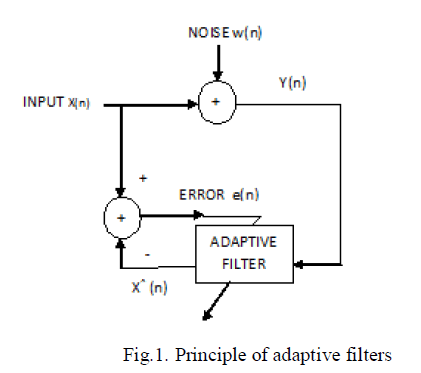 |
IV. ADAPTIVE FILTER ALGORITHMS
|
| Adaptive filter algorithms are broadly classified as stochastic gradient approach (i.e., least mean square algorithm) and least square estimation (i.e., recursive least square algorithm) |
| 1. Least mean square (lms) |
| The LMS algorithm is a method to estimate gradient vector with instantaneous value. It changes the tap weights of the adaptive filter recursively. |
| The error estimation e(n) is given by |
 |
| w(n) represents the adaptive filter coefficient at time n.μ represents the step size. If μ is too small, wïÿýïÿý is small, s o itconverge on the optimal solution will be too long. If μ is too large, wïÿýïÿý becomes unstable and unbounded. |
| 2. Recursive Least Squares Algorithm (RLS) |
| Recursive Least-squares algorithm is one of the method of least squares used for adaptive filter design. The RLS algorithm performs better than LMS algorithm due to the following natures such as it faster convergence rate, minimizes the least squares error between the output and the desired signal, reduced computational complexity. |
 |
V. WAVELET TRANSFORM
|
| In this paper, preprocessing is carried out using wavelet transform. When compared to other transforms like fourier transform we prefer wavelet transform due to the following reasons. Fourier transform represents the signal as the sum of sine and cosine functions which have infinite duration in time. Whereas in wavelet transform the signals are represented as the sum of basic functions which are localized in time leads to more compact representation and also provides better insight into the properties of the signal. |
| In wavelet analysis, signals are represented as a set of basis functions which are derived from a single prototype function called mother wavelet. Basis functions are formed by translating and dilating the mother wavelet. |
 |
| Where d(k,l) represents the discrete wavelet transform of f(t) and k, l are referred to as integers. |
VI. BLOCK DIAGRAM
|
| This block diagram shows the enhancement of adaptive filters using preprocessing technique. First the biomedical signals are picked up from the biomedical instruments. And then it is send to the preprocess block. Here the preprocessing is carried out with the help of wavelet transform. Then only it is send to the adaptive filters for the removal of noise. After that only it is used for diagnosis of a signal. |
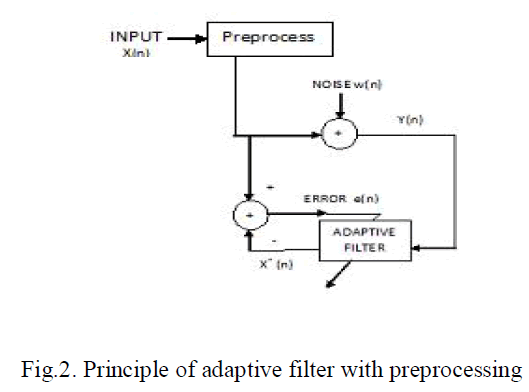 |
VII. MATERIALS AND METHODS
|
| The newly inaugurated Research Resource for Complex Physiologic Signals, which was created under the auspices of the National Center for Research Resources of the National Institutes of Health, is intended to stimulate current research and new investigations in the study of cardiovascular and other complex biomedical signals. The resource has 3 interdependent components, such as PhysioBank, PhysioToolkit, and PhysioNet. |
| PhysioBank is a large and growing archive of well-characterized digital recordings of physiological signals and related data for use by the biomedical research community. It currently includes databases of various biomedical signals from healthy subjects and from patients with a variety of conditions with major public health implications, congestive heart failure, sleep apnea, neurological disorders, and aging. PhysioNet data archive (PhysioBank) currently contains over 10,000 recordings of annotated, digitized physiologic signals and time series, organized in over 50 databases (collections of recordings). All of this software is available in source form, so that it can be studied, validated, and modified if necessary to suit the needs of individual researchers |
VIII. SIMULATION AND RESULTS
|
| In this work, among various biomedical signals a respiratory signal from nasal is carried out for a sample. And its simulation and results are as follows |
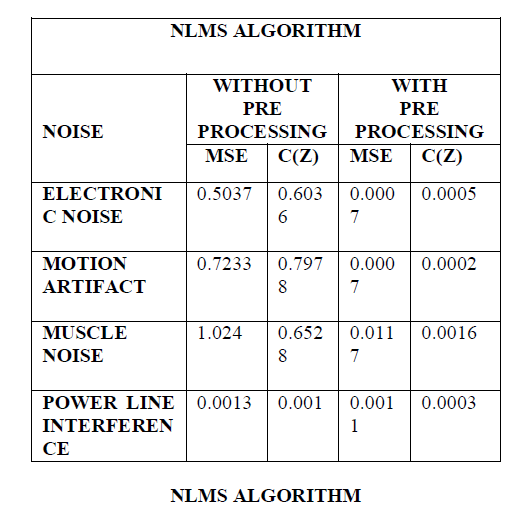 |
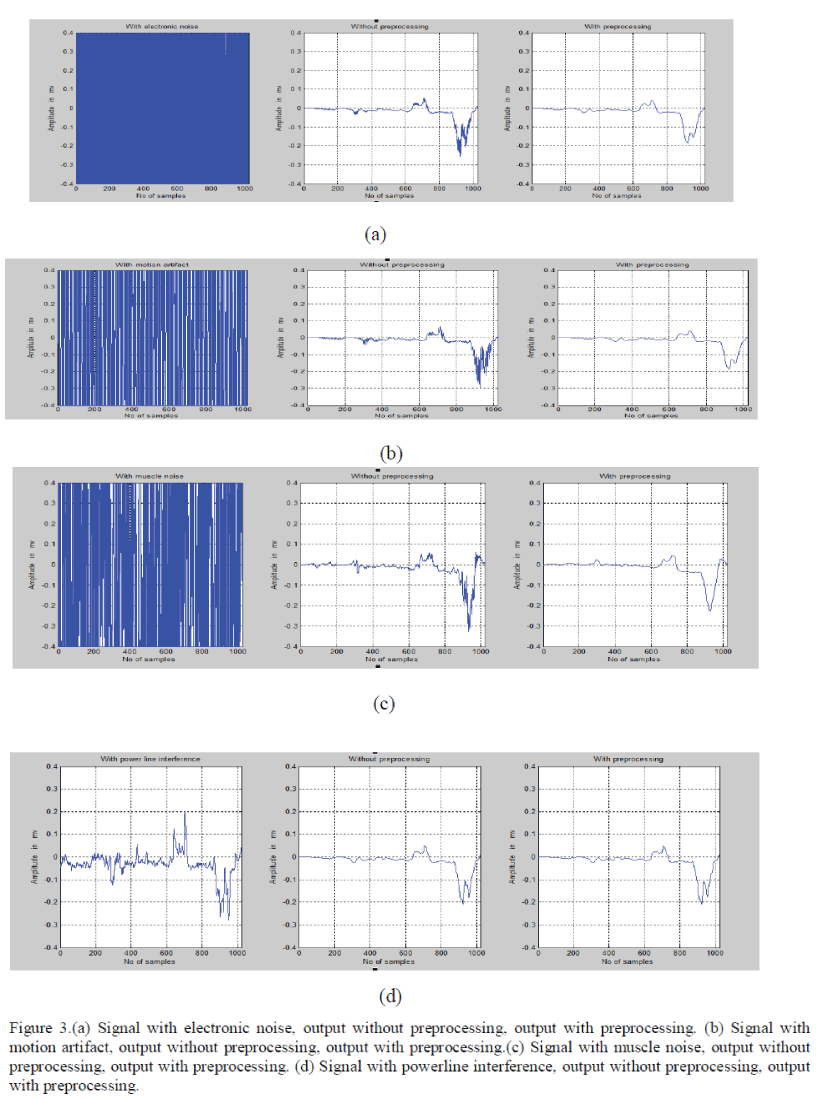 |
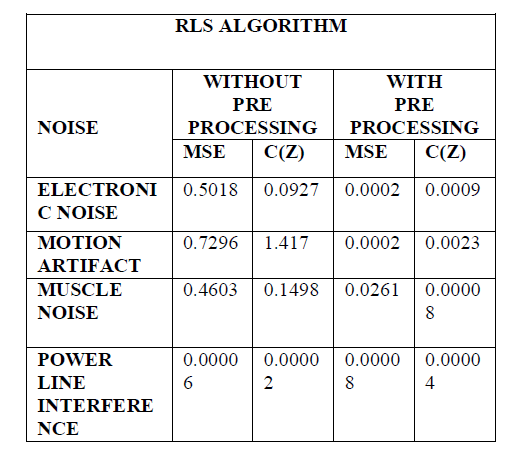 |
| RLS ALGORITHM |
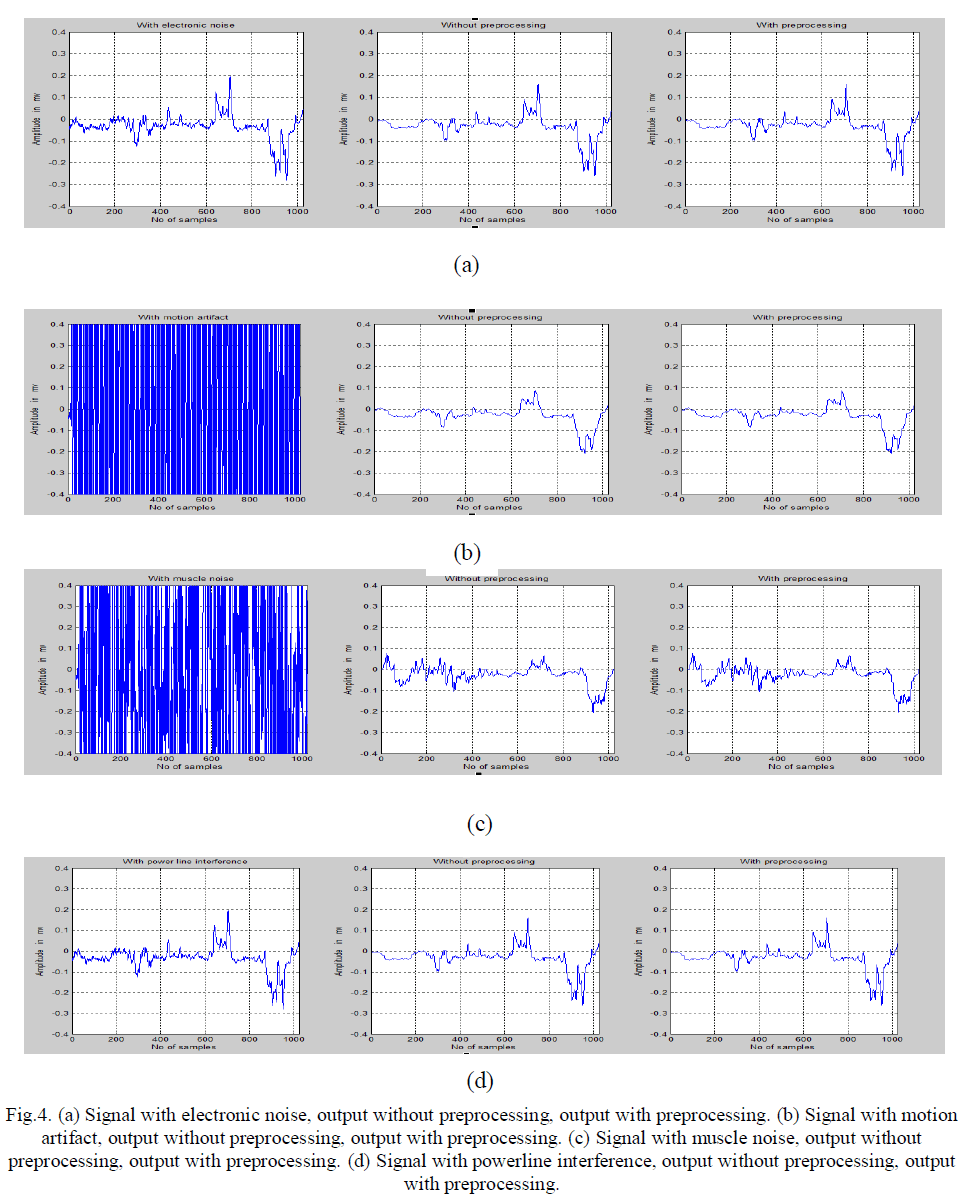 |
| From the above results it is shown that Adaptive filters with preprocessing gives the better result when compared to adaptive filter without preprocessing in terms of its Mean square error (MSE) and convergence rate (c(z)). |
IX. CONCLUSIONS
|
| Adaptive filters are enhanced using preprocessing technique like wavelet transform for better diagnosis in biomedical field. |
References
|
- Syed Zahurul Islam, Syed Zahidul Islam, RazaliJidin, Mohd. AlauddinMohd. Ali, “Performance Study of Adaptive Filtering Algorithmsfor Noise Cancellation of ECG Signal”, IEEE 2009.
- Bhavani Sankar. A, Kumar. D and Seethalakshmi.K “Performance Study Of Various Adaptive Filter Algorithms For Noise Cancellation InRespiratory Signals”, International Journal (SPIJ).
- Md. Zia Ur Rahman, Rafi Ahamed Shaik, D V Rama Koti Reddy, “Noise Cancellation in ECG Signals using Computationally SimplifiedAdaptive Filtering Techniques: Application to Biotelemetry’’, International Journal (SPIJ).
- M. Sifuzzaman, M.R. Islam, M.Z. Ali, “Application of Wavelet Transform and its Advantages Compared to Fourier transform”, Journal ofPhysical Sciences, Vol. 13, 2009.
- Ambarish G. Mohapatra and Sarojkumarlenka , “Motion Artifact Cancellation In Ambulatory ECG Measurement System For TheDetection Of Cardiac Diseases”, Volume 3, Issue 1, 2011.
- Hong Wanl, RongshenFul, Li Shi,“The Elimination of 50 Hz Power Line Interference from ECG Using a Variable Step Size LMSAdaptive Filtering Algorithm” Life Science Journal, 3 (4),2006.
- Mohammad Zia Ur Rahman, Rafi Ahamed Shaik and D V Rama Koti Reddy, “An Efficient Noise Cancellation Technique to remove noisefrom the ECG signal using Normalized Signed Regressor LMS algorithm”, IEEE International Conference on Bioinformatics and Biomedicine ,2009.
- Nitish V. Thakor, Yi-Sheng Zhu, “Applications of Adaptive Filtering to ECG Analysis: Noise Cancellation and Arrhythmia Detection” IEEETransactions on Biomedical Engineering.Vol. 18. No 8. August 1997.
- Allan Kardec Barros and Noboru Ohnishi, “MSE Behavior of Biomedical Event-Related Filters” IEEE Transactions on BiomedicalEngineering, Vol. 44, no. 9, September 1997.
- S. C. Chan, Z. G. Zhang, Y. Zhou, and Y. Hu, “A New Noise-Constrained Normalized Least Mean Squares Adaptive filtering Algorithm”,IEEE 2008.
- Desmond B. Keenan, Paul Grossman, “Adaptive Filtering of Heart Rate Signals for an Improved Measure of Cardiac AutonomicControl”. International Journal of Signal Processing-2006.
- Monson Hayes H. “Statistical Digital Signal Processing and Modeling” – John Wiley & Sons-2002.
|